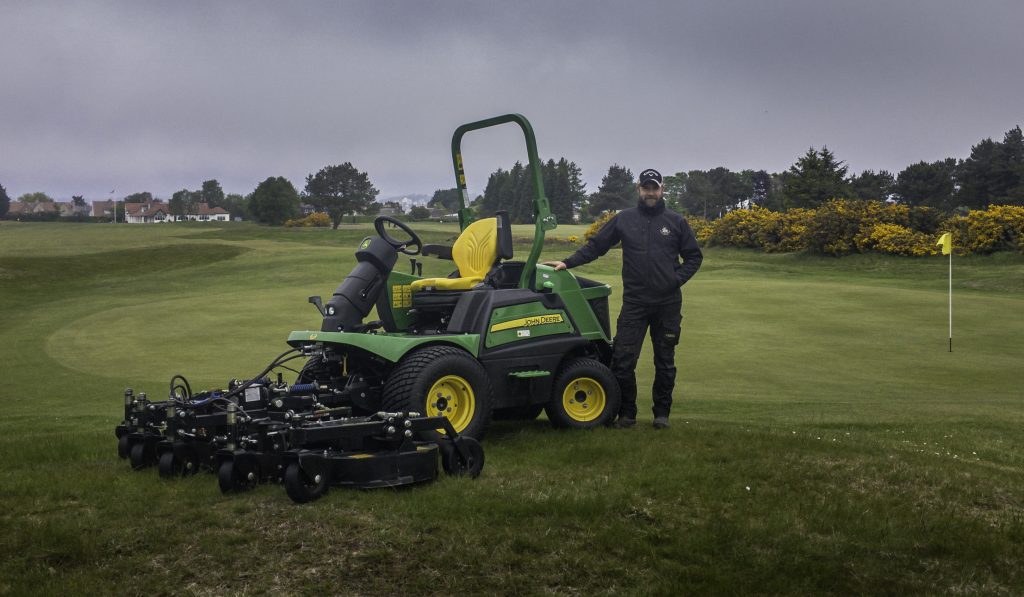Meet the golf course manager: Chris Barnard
Related Articles
The course manager at Scotscraig Golf Club in Fife talks about ensuring the course is maintained as best as possible – even during a pandemic.
Can you give a description of your career path to Scotscraig Golf Club?
Having studied applied chemistry for two years I realised that an outdoor working life would be more suited to me so I began my NC greenkeeping course at Elmwood College in 1999.
I began my career at Kingsbarns Golf Links in early 2000 and was promoted to first assistant in 2007. I left in early 2011 and moved to Paraparaumu Beach Golf Club in New Zealand as deputy course manager. Moving back to the UK in January 2012 I began the role of links superintendent at Royal Cinque Ports Golf Club. I moved back to Fife in 2015 as course manager at Scotscraig Golf Club and I am currently still there.
For me there has been no better way to learn than being hands on and physically doing the work. At this point in my career I would say one of the most important skills I need to have now is problem solving ability and this has evolved through being practical up to this point.
What challenges are you and the team currently experiencing and how have you coped throughout the pandemic to maintain the course and what are your hopes for this season?
We currently have a total of three staff including myself so the main challenge is obviously the lack of manpower. We’ve had to become as efficient as possible which can mean a lot of multitasking. Fortunately we have been focussing on sustainability since I started the role so many things were already being undertaken efficiently. We’re all quite flexible and form a good team so generally we cope with most things thrown at us, even Covid-19! Thankfully there are also some dedicated volunteers at the club who often help in any way they can.
The hopes this season are that our species exchange programme will not stall given the limitations we are currently experiencing.
We also have a Justin Rose Ladies event in August the week prior to the Scottish Ladies Open so we’re currently hoping the weather will be kind between now and then!

What are the things that you enjoy most about your job, what are you most proud of and how does this make you feel?
It’s rewarding to hear the course complimented and we take even more pride in seeing people’s reactions when they find out we’re presenting the course so well with so few staff and limited resources.
It’s reassuring to know the planning and execution of our annual programmes are now paying dividends. As an example we have had no fungicide requirement for five years now.
You invested in a Lastec XF200 front mount mower deck. What were your reasons for selecting this piece of kit, what level of efficiency does it deliver to your course maintenance and how often do you use it as part of your programme and to which areas? How reliable and easy to maintain is it?
We decided on the Lastec deck largely for efficiency reasons. It’s 100 inches wide and mounted on the John Deere 1580 it has more than enough power for anything we require mown. The height of cut is tool-free and very quick to alter. It leaves a very good finish and it is rare that we have to reduce travelling speed even in thicker areas.
Given its width and the available power we have likely reduced rough mowing time by around 30 to 40 percent which is obviously a huge benefit to a small team. During late spring and summer when our rough is growing at its fastest the machine is out every week, sometimes up to three times per week in the worst areas.
We’ve had the deck over a year now and it hasn’t let us down once. It does have a lot of moving parts and therefore many grease points however they are all easy to access and regular lubrication is quickly completed.
You’re undertaking a species exchange programme to the course. What exactly are you looking to achieve? You’ve managed to avoid using fungicide for five years, what’s your secret?
Six years ago the greens were over 90 percent meadowgrass and we quickly realised that bent was its strongest competitor here as it automatically fills in any disease scars with a little help. We are aiming to reverse the populations in the coming years and take the greens to around 90 percent bent, at the moment we probably have an average of 50 to 60 percent bent.
There’s no real secret to reducing our fungicide use, it’s just a case of getting the basics right, timing and selecting the best products for the site. We start each season with a planned approach and generally stick closely to it.
Also, if you can find a way of turning a problem into an advantage or tool then make the most of it. For example, in the last two or three seasons we’ve let anthracnose keep the meadowgrass on the back foot. There’s not a huge margin for error but once you know your site well enough even that can be used as a tool!

























